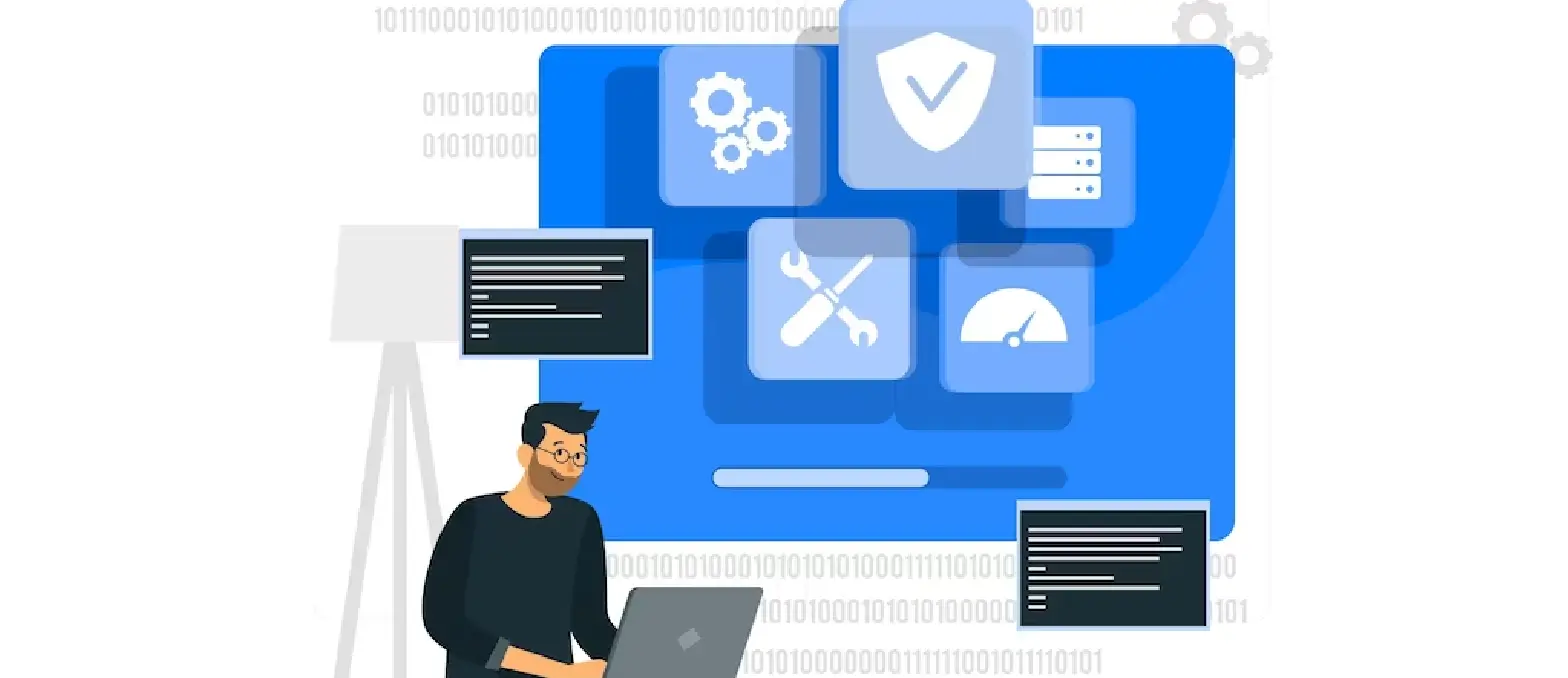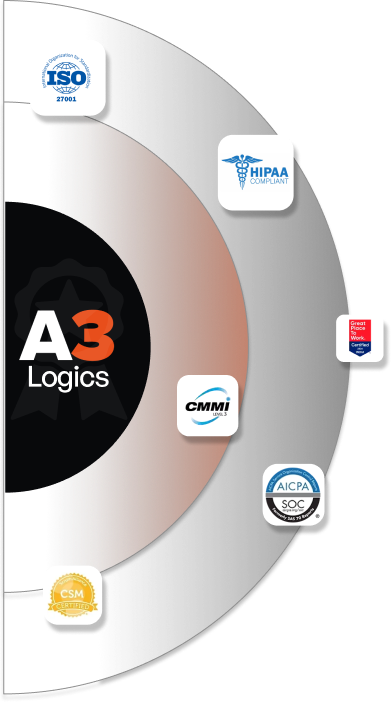Food Donation App Development: Sometimes, we have more food on our plates than we need. Instead of discarding it or, worse, throwing it away, we can give it to those in need. Considering that food waste is a global problem; around 1.05 billion tonnes of food is wasted annually.
But here surfaces another issue—how can we ensure we donate food to those in need in time, before all the essential nutrients are lost, and that it remains consumable? That’s where technology has the answer. You can develop a food donation app to contribute to the noble cause of feeding those in need and eliminating hunger.
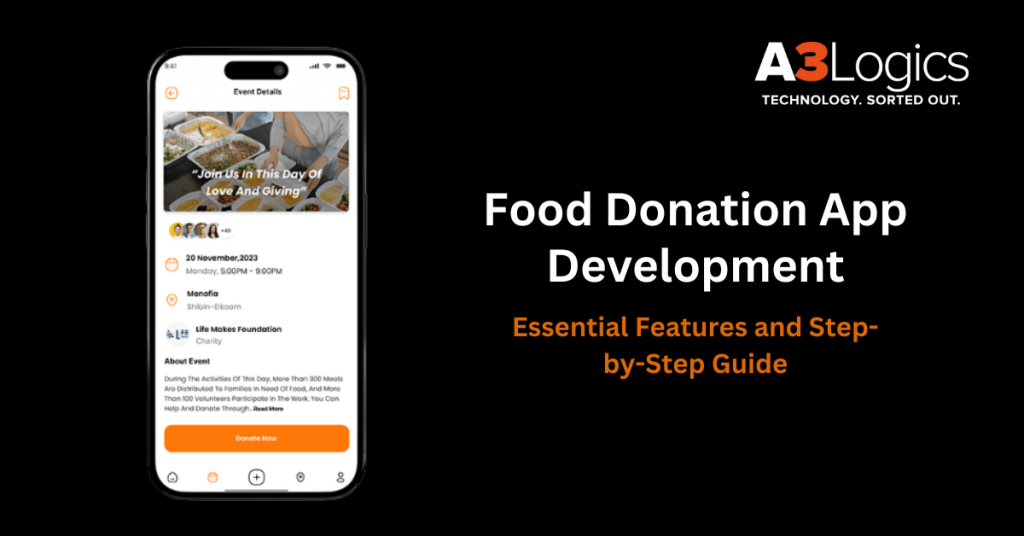
As a developer or business, developing a food donation app will solve the food wastage issue and help save the environment, as food waste contributes to 10% of global gas emissions.
And, while you tackle food waste and help the planet, you can eventually build a platform that can help you generate revenue, something that we’ll discuss in greater detail during this blog.
In this blog, we’ll explain how food donation apps can expedite the food donation process and discuss how you can seek a seasoned company’s food donation app development services to develop a robust app.
Importance of Food Donation App Development
A meal-sharing app is a great way to contribute to society by ensuring that food is not wasted and instead reaches those who might be skipping meals because of circumstances. Let’s have a look at some reasons why investing in developing a food donation app can be meaningful –
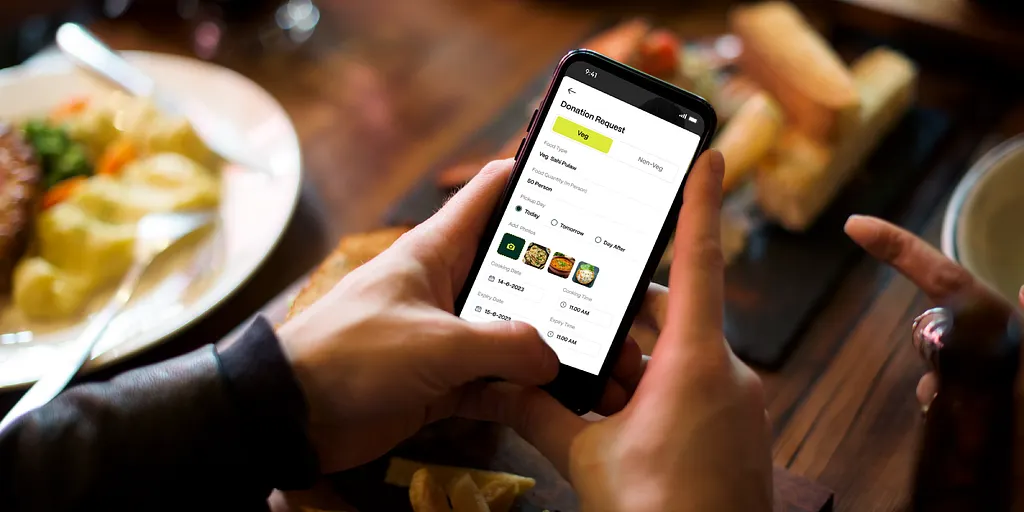
- You can address the global issue of food waste and ensure nutritious food reaches those in need.
- You can develop a platform that connects donors and recipients quickly.
- Contribute to environmental sustainability.
- Encourage others to repurpose edible food items that might otherwise go to waste. This can address food insecurity.
Table of Contents
Must-Have Features In Food Donation App
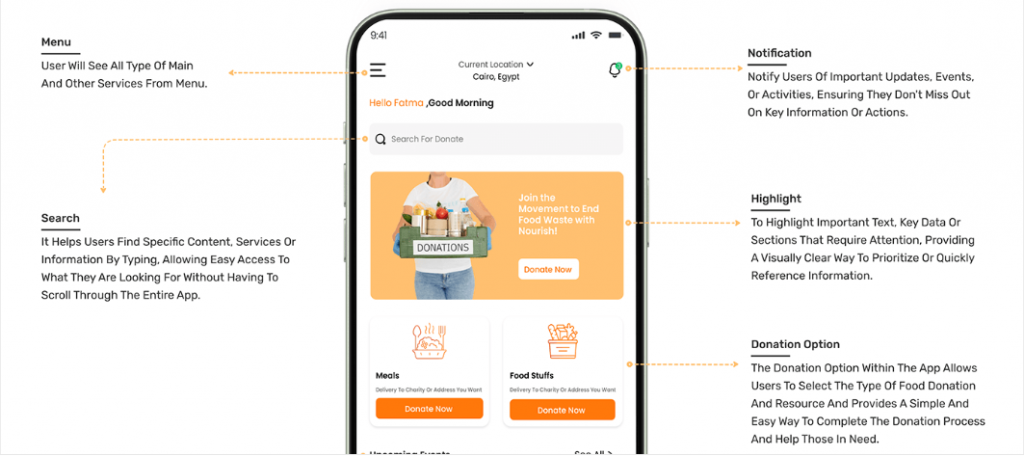
Here are some features that should be present in an ideal food delivery app so that the donation experience is smooth for both food donors and recipients –
1. User-Friendly Interface
An essential aspect of food donation app development is developing an intuitive and user-friendly interface. The interface should be easy to navigate for users regardless of their technical proficiency. Secondly, the design should be responsive and work seamlessly across various devices.
2. Secure and Trustworthy Platform
Another essential aspect to keep in mind when developing a food donation app is ensuring security and data privacy. Adhering to security protocols is crucial since your platform will involve sensitive user information such as personal details and locations. Additionally, you should make an effort to incorporate robust support systems and error handling.
3. Real-Time Notifications and Tracking
Donors should be notified when their donations are picked up and delivered. This step ensures transparency. On the recipient’s end, the food donation app should update them on food availability in real time. This can help with more efficient planning and distribution.
4. Incorporation of Artificial Intelligence
AI is a game-changing technology that enhances any app’s functionality, and your food donation app will be no different. It can enable users to predict donation patterns. Smart matching algorithms can connect surplus food with those in need. AI can also be used to provide automated 24/7 assistance and improve communication between various users – donors, recipients, and NGOs.
5. Compliance and Reporting
Since you are developing an app that deals in food items, your food donation application should also comply with local food safety and regulation compliances. This means your app should be able to provide you with all the important documents and reports for health inspections, tax deductions and it should also be able to integrate with data on food and safety regulations.
6. Accurate Geolocation and Routing
Integrate accurate geolocation and routing algorithms while you develop a food donation app. This ensures that food reaches those in need on time and doesn’t lose its nutritional value once delivered. Also, a food donation app developed by a seasoned company embeds features that allow a donor to connect easily with a nearby recipient.
7. Comprehensive Analytics and Reporting
With a comprehensive analytics and reporting dashboard, administrators can analyze how users interact with the app. The dashboard also features key metrics that can help track donations, beneficiaries, volunteer engagement, and deliveries.
It provides insights into donation trends, food wastage, beneficiary needs, and delivery efficiency. The app also includes reporting tools that a user can customize to get insights into operational data.
Key Technologies Powering Food Donation App Development
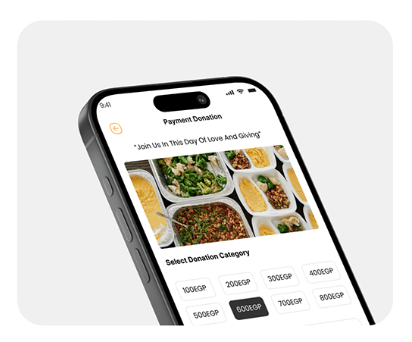
Artificial Intelligence
The unmatched impact of conversational AI in the food industry is undeniable, and . AI can be used in food donation app development to identify food surpluses and connect with organizations that can redistribute excess food to needy people. It can also predict future food donation trends based on historical data and other relevant factors.
Another way in which AI can power food donation apps is by helping food banks manage their inventory more effectively, where they can reduce waste and ensure that food reaches locations where there are more needy people.
Blockchain
Blockchain technology can be incorporated into food donation app development in more ways than one. It can provide a transparent and verifiable record of food donations, making it easy for people involved to track the journey of food items.
Also, with blockchain integration in the food donation app, donors can rest assured that their donations will reach their intended recipients.
Geolocation and GPS
Leveraging geolocation features and real-time tracking can enhance overall convenience, as your food delivery app can make it easy for users to place and track their orders.
With GPS integration, users can see a driver’s estimated arrival time based on the driver’s exact location. The app can also assess the food demand in designated places and accordingly deploy drivers, offering them the fastest route.
It is worth noting that integrating features like GPS and geolocation requires expertise, which a food donation app development company can offer.
Internet of Things (IoT)
IoT integration in food donation apps can enable real-time tracking of food items, their condition, location, inventory, and other crucial factors.
For instance, IoT sensors such as GPS trackers, RFID tags, and environmental sensors can be attached to food items or storage containers. These sensors can continuously collect and transmit food-related data to the food donation app that users can use to allocate resources accordingly.
Cloud Computing
Cloud computing technology is used to develop food donation apps to handle large volumes of data and ever-growing user traffic. It helps adapt to the changing needs without requiring significant investment in infrastructure.
The technology also helps store and manage large volumes of user data securely and centrally. This data could be related to donors, volunteers, or charities.
Mobile App Development Frameworks
It is very important to choose the right mobile app development framework for your food donation app. This decision will impact your app’s scalability, performance, and user experience. The right frameworks expedite the development time, facilitate cross-platform compatibility, and enhance security.
If you have a food donation app concept and are unsure of what mobile app development framework to use, you can seek the assistance of a professional mobile app development company.
Below is the list of technologies that ensure fast and efficient meal donations through the app –
| Frontend Development | Native user experience – Reactive Native and Flutter Web-based apps – Angular and React |
| iOS | Swift is an easy-to-use language that offers safety features and easy integration with Apple’s ecosystem. |
| Android | Kotlin is used for its interoperability with Java and its capability to enhance developer productivity. |
| React Native | Allows code reuse across iOS and Android platforms. Helps in creating cross-platform applications. |
| Flutter | Offers a single codebase for Android and iOS and helps create visually appealing apps. |
| Backend Development | Node.js – ideal for handling event-driven real-time features. (For example, donation matching). Django/ Flask – For developing and managing data-heavy applications. |
| Database Management | MySQL and PostgreSQL – Offer structured relational capabilities and can manage users and donations. MongoDB – Handle unstructured data |
| Cloud Services & Storage | Platforms like AWS and Google Cloud Platform offer robust data management capabilities and scalable infrastructure. |
Data Analytics
We just mentioned how IoT can help collect crucial food-related data. The app can help users analyze historical data and predict future food needs. Leveraging this information, inventory levels can be optimized and waste minimized.
A food donation app can help access data records demonstrating past donation patterns. These patterns can be used to predict various aspects, such as future food demand, optimized food delivery routes, relevant donation opportunities, etc.
Key Technological Challenges in Food Donation App Development (& Possible Solutions) –
A food donation can make a tremendous difference, but it comes with challenges. Let’s quickly examine some of the key challenges associated with adopting technology. We’ll also address how to overcome these challenges by suggesting practical solutions –
| Challenge | Description | What Can Be Done? | |
| 1. | Food spoilage | How to prevent food spoilage by ensuring timely communication between donors, volunteers, and receivers? | Integrate alerts and instant notifications, allowing all parties to receive updates about food surplus and donation requests. |
| 2. | UI/ UX for non tech savvy users | How to create an intuitive and easy-to-navigate food donation app that can be used by all users, regardless of their tech saviness? | Design an easy navigation. Focus on essential functions and ensure that they are responsive and that users can quickly access them. |
| 3. | Data privacy and security | How to create a platform that ensures data, and privacy security? | Implement robust security measures, such as multi-factor authentication and military-grade encryption, to prevent the theft of personal user data and transactions. |
| 4. | Logistics management | How to handle the complexity in logistics-related aspects such as managing fod storage, pickup and drop points, and distribution? | Integrate GPS and Geolocation services can help monitor all logistics-related aspects seamlessly. |
| 5. | Cross integrations with multiple platforms | How to integrate the food donation app platform with GPS systems, payment gateways, and other platforms? | Leverage APIs for payment gateways, GPS systems, and other platforms using SDKs or manual coding. |
What Are Some Security And Compliance Technologies For Food Donation App Development?
A food donation app must comply with relevant regulations and privacy laws, for which it must implement certain technologies. Here’s a detailed breakdown –
Advanced Security Technologies
- Data Encryption
To protect sensitive user data such as donation details and personal information during transmission and storage, use strong encryption technologies such as RSA, AES, etc, to scramble data. Such techniques make the data unreadable without a proper key.
- Secure Communication Protocols
Use techniques such as SSL, TLS, and HTTPS to transmit data securely between the food donation app, servers, and other systems involved.
- Robust Authentication and Access Control
To prevent unauthorized access, use various security techniques, such as multi-factor authentication, biometric authentication, and secure login mechanisms. Furthermore, implement role-based access controls to restrict access.
- Secure Coding Practices
Assuming that the app may be introduced to vulnerabilities such as injection attacks, scan the code from time to time, use input validation, secure coding guidelines and input sanitization.
- Security Audits
Penetration testing and regular security audits can help identify and keep vulnerabilities in check.
Reliable Compliance Technologies
- Food Safety Compliance
Implement a food-grade assessment to ensure that donated food is safe for consumption. The app should provide clear information about food storage conditions and expiry dates.
- Data Privacy Compliance
Implement data retention policies, data minimization, and purpose limitation to comply with data privacy regulations like CCPA and GDPR.
- Be Transparent About How User Data Is Handled
Through your app, communicate to your users how their data is handled, used, and protected. Also, provide users control over their data.
How To Develop A Food Donation App?
Now that we have touched upon various aspects of food donation app development, like what a food donation app is, the tech stack involved, and the keys and benefits, let’s discuss the important stages involved in developing a food donation app –
Step 1 – Conceptualize
The first step is to understand the goals of the food donation business. Here, it is essential for the food donation app development company to first conduct thorough market research. The developers must identify the key features that the business wants to incorporate in their app. It might also benefit to go through use cases and personas relating to the end users.
Step 2 – Create a Technical Specification Document
After the concept for the food donation app is clear and all the requirements are set, you can detail the technical specifications—the tech stack you want to use, the data flow diagrams, the UI/ UX design, and the security protocols.
Step 3 – Development
In this stage, the core development takes place. Developers integrate the features, handle the backend and frontend development, and integrate systems into the platform. For instance, the developers may want to integrate secure payment gateways, GPS systems for smooth navigation, AI/ ML algorithms, etc.
Step 4 – Testing and QA
Once the food donation app is built, it must be rigorously tested before being launched on various platforms, such as the Google Play Store or the App Store. This step helps identify and resolve any flaws, security vulnerabilities, scalability challenges, and other issues to make the app fit for real-world use.
Step 5 – Deployment of Popular Platforms
After ascertaining that the app works smoothly, it can be deployed on popular platforms. Here, a robust server infrastructure is set up to ensure that the app can process data effectively and handle a heavy user load.
Step 6 – Post Launch Maintenance
Even after launching the food donation app, users may still face ongoing challenges or expect new features. These aspects are covered in post-launch maintenance where the makers of the app roll out new features, roll out updates to resolve bugs, and also make adjustments based on user feedback.
How Can a Food Donation App Help Generate Revenue
A food donation app can help you generate a good amount of revenue for your business. Let’s discuss some revenue generation models for your food donation app that can help you scale your business in terms of operations and profitability.
Advertisements
There are multiple ways in which a food donation app can earn from advertisements
- Show sponsored content or special deals from food-related companies in return for fees.
- Generate revenue from ads that users may see on various platforms.
- Earn affiliate income by partnering with popular food brands, NGOs, etc.
Transaction Fees
In this model, you can charge a nominal fee for each transaction carried out through your app.
Freemium Version
You can offer a freemium version of your food donation app so users can access the basic features. However, if users want to access advanced features like advanced GPS tracking or priority matching, they can pay a nominal fee and subscribe to these features.
In-App Donation
This feature motivates donors to donate to the app, which can be used to carry out operations and fund charities.
Subscription Model
In this innovative model, you can encourage businesses such as grocery stores and restaurants to list their surplus food on your platform in return for a subscription fee.
How A3Logics Can Help Develop a Food Donation App ?
Do you wish to develop a food donation app that can change the planet by reducing food waste?
A3Logics can help. We have a team of dedicated food donation app developers who can help you create a food donation app powered with all the features you desire. We can help you develop a platform that can further help your users contribute/ receive leftover food, groceries, and other food items with the utmost ease.
Why Choose A3Logics’ Food Donation App Development Services?
Here are some reasons why A3Logics can be your perfect partner in your food donation app development journey –
- We provide on-demand food donation app development services that cater to your business’s particular needs.
- We hire mobile app developers who are experienced in developing feature-rich, secure, and scalable food donation applications.
- We can replicate the success of popular food donation apps.
- We leverage trending technologies like AI, blockchain technology, IoT, and cloud computing to develop custom food donation apps.
To know more, book a consultation now!
Conclusion – Food Donation App Development
Developing a food donation app is a great way to reduce wastage and ensure that nutritious food items reach those in need. As we established in this post, a food donation app for your food business can also generate a considerable amount of revenue, which makes this venture a win-win opportunity.
So, if you have an idea for a food donation that you think will make a big change in the world, but aren’t sure how to bring it to reality, you can hire food donation app developers. Do let us know if this post provided value that you were looking for in the comments section below.


